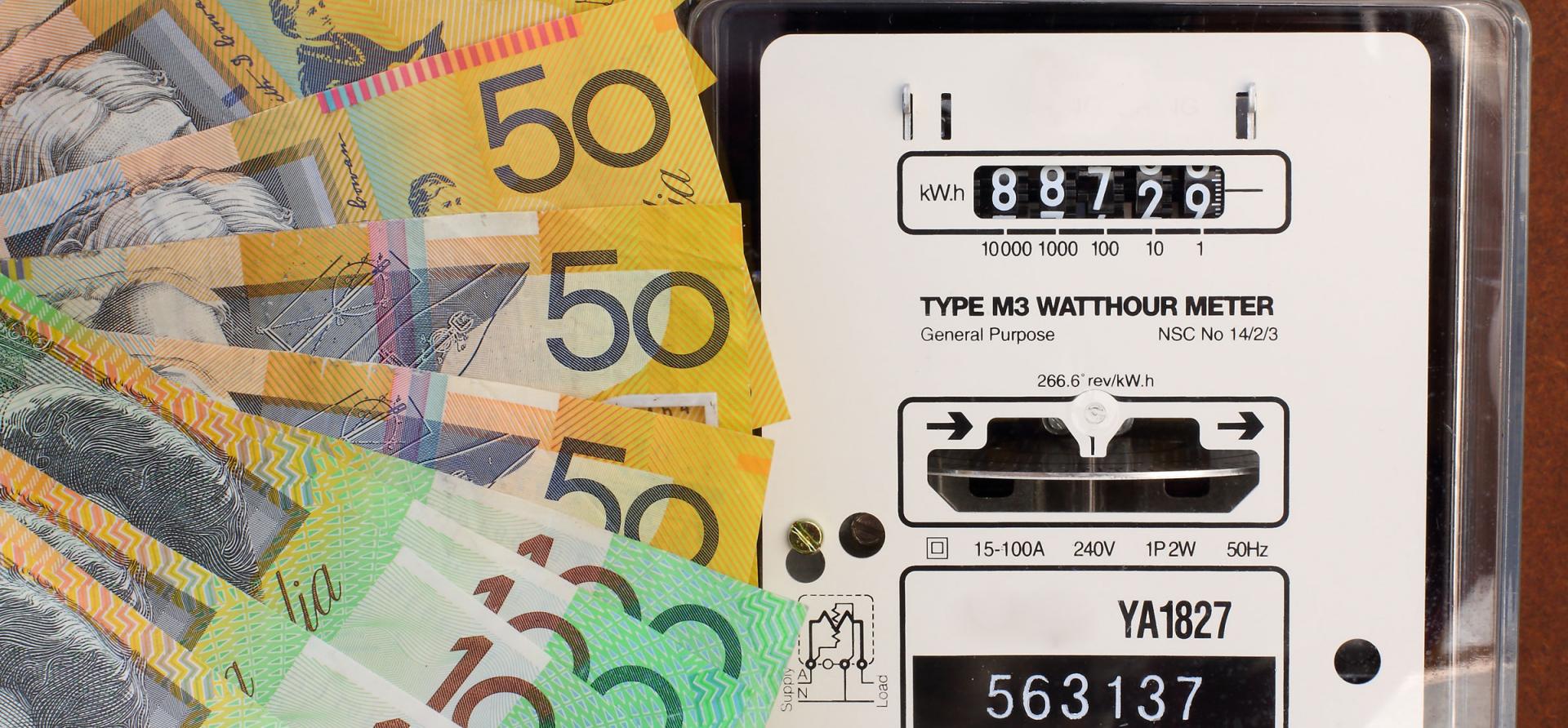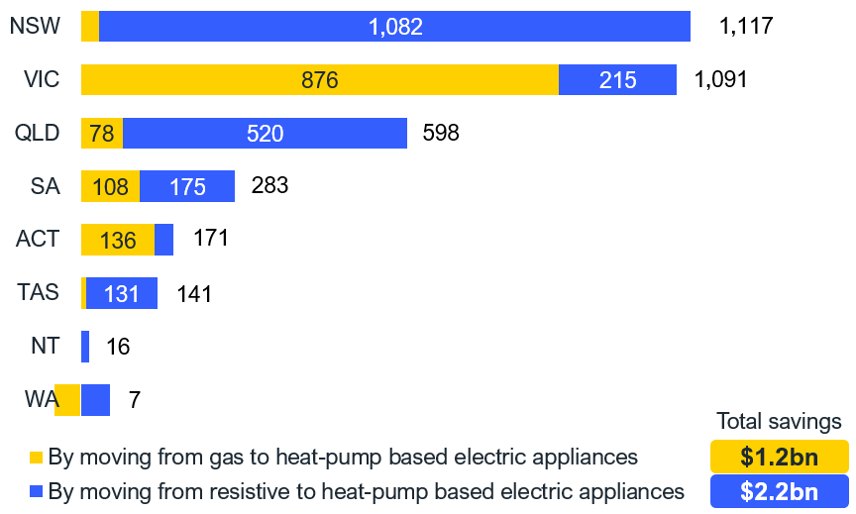Fast, efficient, flexible electrification can cut energy bills and support the shift to renewables

Key Findings
Australians are incurring more than $3 billion in unnecessary energy costs for each year of delay in shifting to highly efficient, all-electric appliances.
Distributed energy resources (DER) and flexible demand can deliver lower electricity system costs for everyone, and unlock even greater energy bill savings.
Urgent government action is required to support fast, efficient, flexible electrification and effective deployment and integration of distributed generation and storage technologies.
The financial case for fast electrification continues to gain strength, with growing evidence that it could slash energy bills for Australians and expedite the transition to renewables.
Efficient electric appliances are cheaper than gas appliances when considering the full costs over their lifespan. In Victoria, IEEFA calculated that an average household would save about $1,200 each year if it replaced its gas appliances with efficient electric alternatives at the end of their life. Despite this, nearly a million gas appliances continue to be sold every year in Australia. Each year, these new gas appliances lock in an unnecessary $1.2 billion in lifetime energy costs for households across the country. Victoria is the most affected state, bearing nearly $900m of this total cost.
This is not the only significant cost arising from delaying electrification; there is also the missed opportunity to solve the upcoming gas supply gap challenge. The Australian Energy Market Operator (AEMO) expects gas supply to reduce faster than gas demand in the southern states, creating a supply gap from 2027 onwards. While public debate has focused on the need to increase gas supplies to fill the gap, IEEFA instead looked at reducing gas demand faster.
We found there is enough potential to cost-effectively accelerate gas demand reduction to eradicate the gas supply gap or at least delay it by 10 years. The two largest opportunities are residential and industrial electrification – moving to all-electric appliances, and accelerating the deployment of industrial heat pumps. In total we found that cost-effective interventions could reduce gas demand in the southern states by about 80% by 2045, and by over 40% by 2030.
Focusing on how we can reduce gas demand rather than increasing supply is critical for several reasons. One reason is that there is no space for new gas developments under the Paris Agreement. The International Energy Agency (IEA) estimated in its latest World Energy Outlook that there are enough locked-in investments in oil and gas projects to meet global gas demand under a 2.4°C scenario, and much more than what is needed under Paris-aligned scenarios.
The energy crisis following the Ukraine war triggered an enormous amount of investment in gas supply – new confirmed liquefied natural gas (LNG) projects due to come online in the next few years are equivalent to nearly half of the existing LNG capacity globally. In addition to compromising global climate goals, new gas investments come at a high cost, which suppliers will seek to recover via energy bills, along with a profit margin. On the other hand, gas demand reduction reduces energy bills for consumers, and delivers a range of other advantages including health benefits and higher job creation.
We need efficient, flexible electrification
As with the untapped opportunity to move from gas appliances to efficient electric appliances, IEEFA has analysed the financial case for moving from traditional resistive heaters and water heaters to heat pumps. Heat pumps consume between a third and a fifth as much electricity than as resistive equipment. As a result, even with higher upfront costs, they are much more cost-effective over the full life of the appliance.
We calculated that every year, buying new resistive appliances costs Australians $2.2 billion in unnecessary energy costs compared with if they were buying heat pump-based appliances (reverse-cycle air conditioners or heat pump hot water systems). States that have traditionally relied on electricity for heating and hot water tend to have the largest opportunity. This includes New South Wales – with more than $1 billion of potential savings each year – and Queensland, with more half a billion dollars in potential savings. Tasmania could also make disproportionately high savings for its small population.
Figure: Total lifetime savings per year

Source: IEEFA analysis
Another key benefit of moving to high-efficiency appliances is that it would significantly reduce electricity demand. We calculated that moving from resistive heating to heat pump-based appliances across Australia would cut residential electricity demand by about 20% by 2045. This could more than compensate for the estimated 13% increase in residential electricity demand that would result from efficient electrification. This would also make the electricity transition easier by reducing the new renewable generation capacity required to meet the government’s 82% renewable electricity target.
Efficient electrification can also make the renewable electricity transition easier by providing a large capacity of flexible demand. Electric water heating could be set to run in the middle of the day when solar generation is at its highest, reducing minimum demand issues and acting as an energy storage system.
The University of Technology Sydney (UTS) recently completed a comprehensive analysis of the potential to transform domestic hot water into a resource for the energy system. It found that if water heating was electrified fast, efficiently and made flexible, it could provide 22 gigawatts (GW) of storage, or 45 gigawatt-hours (GWh) of flexible demand per day by 2040 – about 60% of AEMO’s forecast for distributed storage. This would provide more than $6 billion in savings for consumers by 2040.
However, there are currently no requirements for hot water systems to be made flexible, and the default settings are still generally for them to run overnight. A national hot water strategy could inform how many water heaters should have basic controls and be set to run at specific times of the day, compared with systems with more sophisticated capabilities such as the ability to interact with the house’s solar system, or to be controlled remotely to provide demand response services.
Distributed energy resources and electrification can lower costs for everyone
Demand response is just one of the benefits that can be delivered for the energy system by distributed energy resources (DER). IEEFA recently reviewed nine studies of those benefits. We found that DER could effectively serve as a ‘Swiss Army knife’ for the electricity system – it has the ability to deliver multiple services: electricity generation, storage, flexible demand, network services, ancillary services and emergency capacity. Enabling DER to scale up and provide a range of grid services could deliver material economic benefits: about $19 billion in avoided storage, generation and network costs by 2040; as well as an additional $10 billion in consumer benefits from reduced generator super profits.
Most of those consumer benefits would come from reductions in peak demand. For example, last year ITP Renewables modelled what would happen if all houses that could have solar on their roof did, and had a battery system that could trade with other neighbouring batteries. It found that this could ‘put the duck curve to sleep’ – it would eradicate the evening peak and reduce summer network peaks, which should lead to extensive electricity cost reductions for everyone.
A conservative assessment of how DER and electrification could impact consumer electricity bills was recently undertaken by the CSIRO for Energy Consumers Australia (ECA). It modelled delivered electricity prices if the uptake of electric appliances, electric vehicles (EVs) and home storage was aligned to AEMO’s most likely Step Change scenario. It found that the growth in volume of electricity sold would be more significant than the growth in peak demand, leading to increased utilisation of distribution networks and lower prices.
CSIRO’s Chief Energy Economist Paul Graham said: “If demand increases outside of peak times that means there’s no requirement for new infrastructure. Instead, it just makes better use of existing assets, and the cost per unit drops.”
CSIRO found that the average National Electricity Market (NEM) electricity bill would decrease by 34% by 2050 compared with 2023, despite large increases in electricity usage, with the majority of the savings achieved by 2030.
One system benefit that remains poorly understood is the potential contribution of EVs. As an illustration, benefits of increased EV penetration to the energy system were not included in the cost/benefit analysis of the government’s recently proposed Vehicle Efficiency Standard, despite enormous potential. Recent analysis by EnX for ARENA found that by 2050, the total battery capacity in the EV fleet in Australia will be about four times the total storage requirement in the NEM. The report found that: “By the early 2030’s, EV battery capacity is likely to surpass all other forms of storage in the NEM, including Snowy 2.0.”; and that “Flexible bidirectional charging (Vehicle to grid) from only 10% of EVs could provide 37% of total NEM storage needs, offsetting around $94 billion of large-scale battery storage investment (at current prices).”
Based on several studies, our team estimated that the full potential revenue streams from “vehicle-to-everything” (V2X – encompassing a range of potential services provided by EVs, including exporting power to a home or building (V2H/B), to the grid (V2G), or directly to an electrical appliance (V2L)) for a household with an EV could be between $1,000 and $3,700 per year. If included in the Vehicle Efficiency Standard’s cost-benefit analysis, these benefits would likely make the most ambitious scenario the most beneficial to Australia’s economy.
The financial and economic benefits of fast, efficient and flexible electrification, combined with distributed generation and storage, are enormous. However, these benefits will not be realised without urgent government action. The government needs to:
- Develop and update standards to ensure new appliances and equipment sold today are as efficient as possible and have all the features we need to optimise our energy system – with the establishment of a body that can do this in a timely, expert-informed manner.
- Change the energy system rules and settings to ensure DER can deliver its full potential and operate on a level playing field with large-scale solutions.
- Move to efficient all-electric homes – as fast as possible.
- Accelerate the deployment of industrial heat pumps.
- Develop strategies for our hot water systems and EVs, to ensure they can support the energy transition and lower costs for everyone.
- Ensure a smooth transition by addressing challenges around supply chains, homes that are harder to electrify, and financing solutions to ensure the change is affordable for everyone.
Amid an ongoing cost of living crisis, there is no time to waste to act on these issues and deliver lower energy bills for households and businesses across Australia, while facilitating the transition to a renewable electricity system.
Amandine Denis-Ryan will be discussing the issues explored in this article in a presentation at Smart Energy Expo 2024 in Sydney on 6 March. To view Amandine’s presentation slides, click here.













